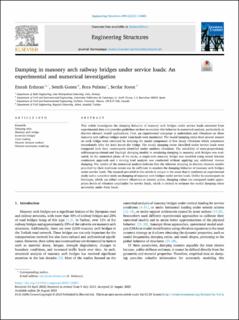| dc.contributor.author | Erduran, Emrah | |
| dc.contributor.author | Gonen, Semih | |
| dc.contributor.author | Pulatsu, Bora | |
| dc.contributor.author | Soyoz, Serdar | |
| dc.date.accessioned | 2023-11-22T07:58:01Z | |
| dc.date.available | 2023-11-22T07:58:01Z | |
| dc.date.created | 2023-10-06T12:11:34Z | |
| dc.date.issued | 2023 | |
| dc.identifier.citation | Engineering structures. 2023, 294 . | en_US |
| dc.identifier.issn | 0141-0296 | |
| dc.identifier.uri | https://hdl.handle.net/11250/3103985 | |
| dc.description.abstract | This article investigates the damping behavior of masonry arch bridges under service loads extracted from experimental data and provides guidelines on how to emulate this behavior in numerical analysis, particularly in discrete element model applications. First, an experimental campaign is undertaken and vibrations on three masonry arch railway bridges under train loads were monitored. The modal damping ratios from several sensors on each bridge were extracted by isolating the modal component of free decay vibrations which commence immediately after the train leaves the bridge. The modal damping ratios identified under service loads were compared with their counterparts identified under ambient vibrations. The suitability of mass-proportional, stiffness-proportional and Rayleigh damping models in emulating damping in masonry arch bridges was evaluated. In the numerical phase of the study, a single-arch masonry bridge was modeled using mixed discrete continuum approach and a moving load analysis was conducted without applying any additional viscous damping. The results of the numerical analysis indicate that the inherent damping in discrete element models provided by their nonlinear nature can be sufficient to emulate the damping behavior of masonry arch bridges under service loads. The research provided in this article is unique in the sense that it combines an experimental study and a numerical study on damping of masonry arch bridges under service loads. Unlike its counterparts in literature, which use either ambient vibrations or seismic action, damping values are computed under appropriate levels of vibration amplitudes for service loads, which is critical to estimate the modal damping ratios accurately under these loads. | en_US |
| dc.language.iso | eng | en_US |
| dc.rights | Navngivelse 4.0 Internasjonal | * |
| dc.rights.uri | http://creativecommons.org/licenses/by/4.0/deed.no | * |
| dc.title | Damping in masonry arch railway bridges under service loads: An experimental and numerical investigation | en_US |
| dc.type | Peer reviewed | en_US |
| dc.type | Journal article | en_US |
| dc.description.version | publishedVersion | en_US |
| cristin.ispublished | true | |
| cristin.fulltext | original | |
| cristin.qualitycode | 2 | |
| dc.identifier.doi | 10.1016/j.engstruct.2023.116801 | |
| dc.identifier.cristin | 2182413 | |
| dc.source.journal | Engineering structures | en_US |
| dc.source.volume | 294 | en_US |
| dc.source.pagenumber | 12 | en_US |

